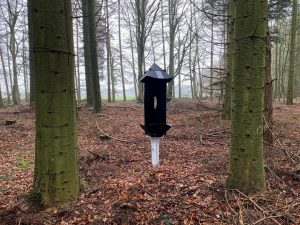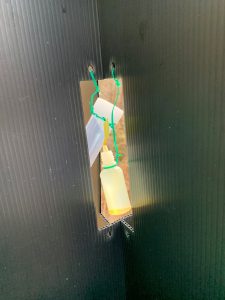Summary
The Forest Trapping Network (FTN) is a Great Britain-wide, broad-spectrum surveillance network which monitors for GB priority pest and EU quarantine organisms that other survey methods are unable to detect. The FTN is a rolling programme which will survey 4-6 woodlands within 100 forests for quarantine pests over five years. In each forest, insect traps are placed in plots of oak, pine, spruce, fir and mature mixed broadleaves to target different pest species. The FTN also monitors the abundances of native and established insect pests that are of interest to tree-health.

Research Objectives
The FTN has been designed as the key survey strategy of the Future Surveillance Plan (FSP). The FSP is a high-level surveillance plan developed by Forest Research, Forestry Commission, Scottish Forestry, Welsh Government, and Natural Resources Wales, to specify surveys for GB priority pest and EU quarantine organisms as described in The Plant Health (Phytosanitary Conditions) (Amendment) (EU Exit) Regulations 2020 (https://www.legislation.gov.uk/uksi/2020/1527/schedule/1). The FTN targets insect pests that the other survey methods of the FSP (e.g. drone & aerial surveys, National Forest Inventory) cannot effectively monitor for. Results are reported to Defra, and Scottish and Welsh governments, at the end of each financial year. The presence or absence of quarantine pests are reported to the EU at the end of each five-year period. This work is crucial to ensure that Great Britain gains approval from the EU to continue trade wood products to the EU as a Third Country (https://www.forestresearch.gov.uk/tools-and-resources/fthr/pest-and-disease-resources/eu-exit-and-tree-and-forestry-pests-and-diseases/), and also to ensure the early detection of invasive pests that threaten the health of our forests. The objectives of the FTN are to:
- Form a key FSP survey strategy which targets quarantine pests that other survey methods cannot detect, including:
-
- many non-native species of Scolytinae (bark beetles) including Ips typographus, Ips duplicatus, Polygraphus proximus, Pseudopityopthorus minutissimus and P. pruinosus
- several species of non-native Pissodes
- Monochamus spp. and other non-native longhorn beetles
- the oak timberworm beetle Arrhenodes minutus.
- Consolidate current trapping programmes into a single network to ease logistical issues (aiming to replace some existing trapping programmes long-term, e.g., the Pest Free Area Billet Trapping Network)
- Improve current trapping methods for quarantine pests
- Ensure a cohesive approach across all agencies from the three participating countries (England, Scotland and Wales)

Latest Update
Alpha-phase (2022) • 38 insect traps (cross-vane) deployed across 10 forests in southern England and samples collected between April and September. • All insects from target groups were identified to species by entomologists at Alice Holt and Northern Research Station. • Only one quarantine species was found, Ips typographus, at one site in the area of southern England where it is known to be present (the Ips demarcated area, https://www.gov.uk/guidance/eight-toothed-european-spruce-bark-beetle-ips-typographus#map). Surveys were undertaken at the site and no further individuals nor breeding galleries were detected. • Data analysis revealed that very good sampling coverage was achieved. • Collaborations initiated between Forest Research, Forestry Commission, Scottish Forestry, and Natural Resources Wales to expand the FTN to Wales and Scotland in 2023. First year of the Beta-phase (2023) • 109 traps (cross vane) deployed across 10 forests in England, 10 forests in Scotland and 4 forests in Wales. Samples were collected between March and September. • All insects from target groups are being identified to species by entomologists at Alice Holt and Northern Research Station. • Only one quarantine species has been found so far, Ips typographus. One record was from the Ips demarcated area in southern England. One further adult Ips typographus was collected in a Fife woodland in June 2023. Surveys revealed no evidence of breeding populations, so it is suspected that the individual in question hitchhiked into the country from mainland Europe (https://forestry.gov.scot/news-releases/forest-surveillance-working-well).
Funding & Partners
-
 Scottish Forestry
Scottish Forestry -
 Forestry Commission England
Forestry Commission England -
 Welsh Government
Welsh Government
